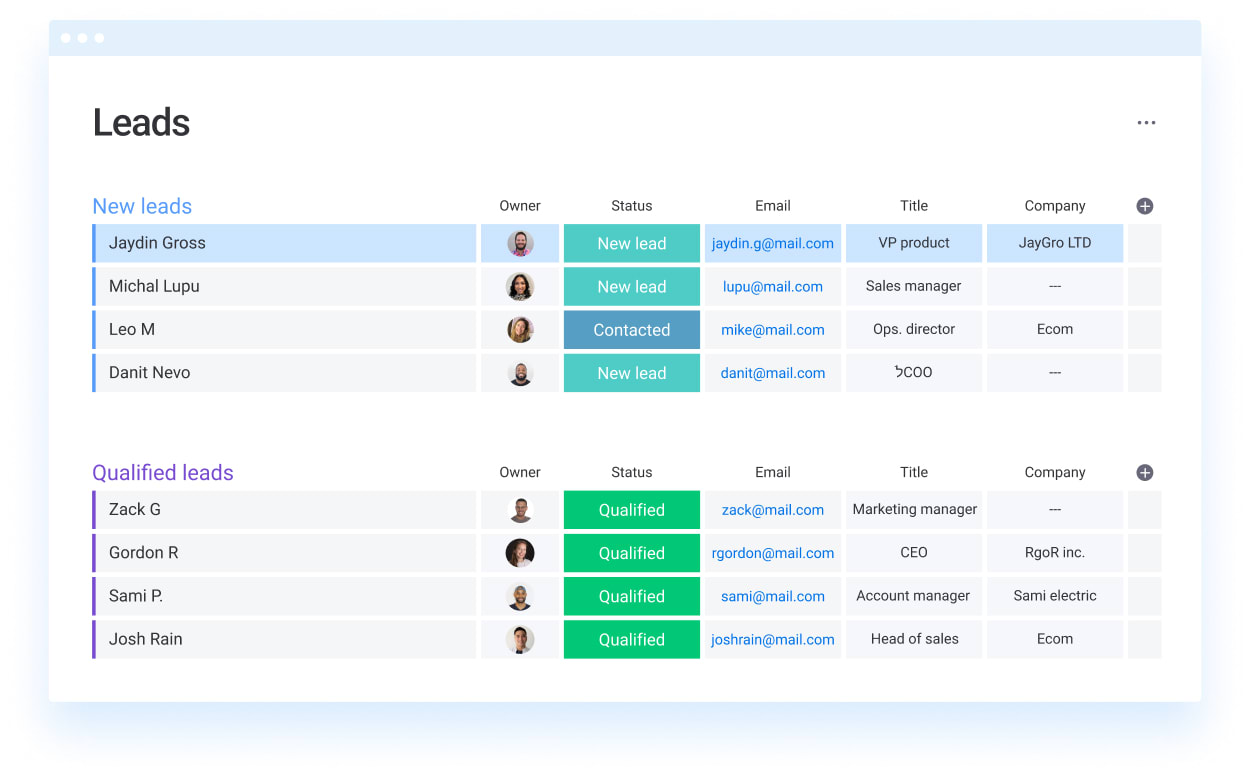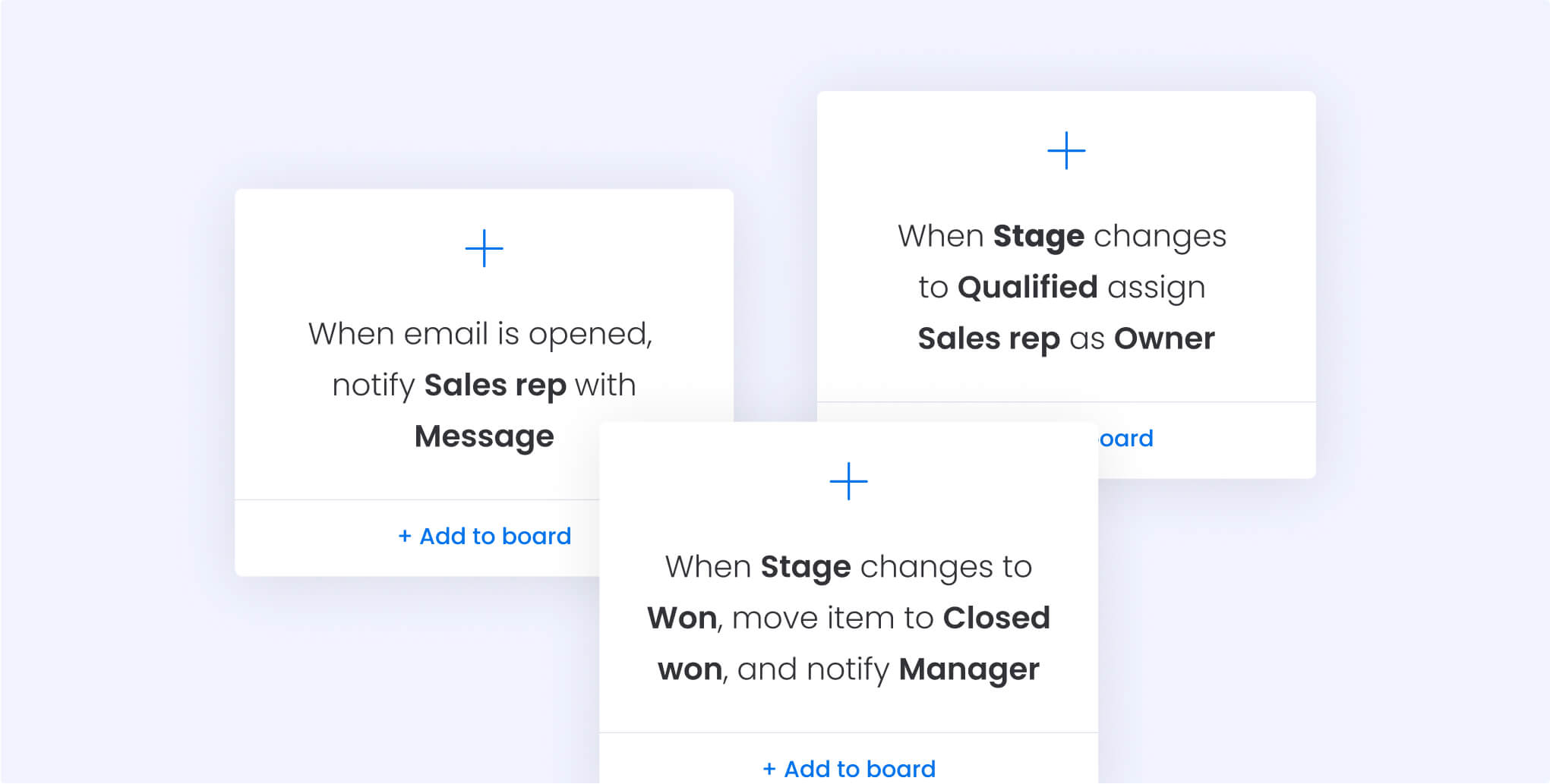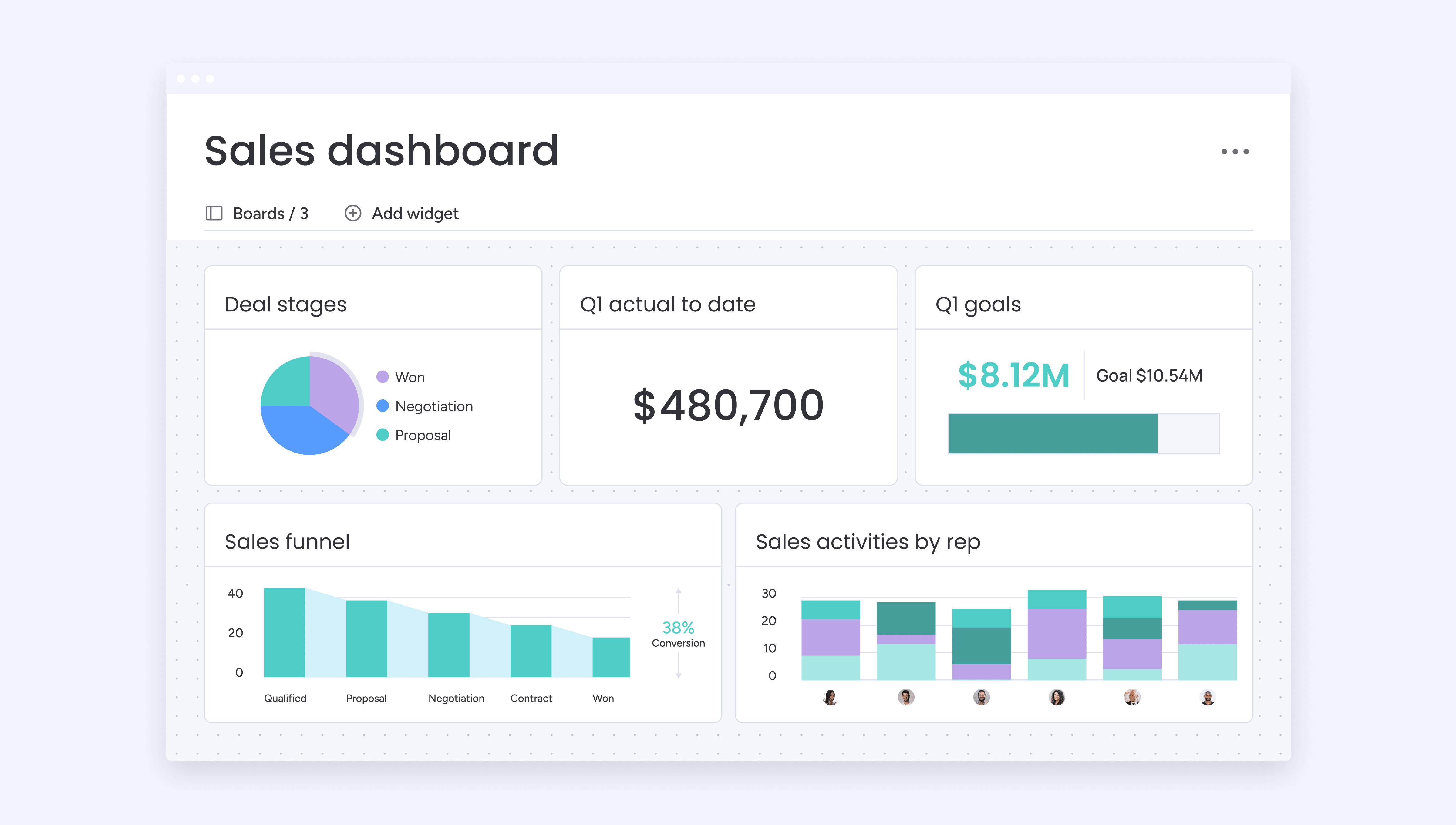Proper lead management is the bread and butter of any sales team. Companies are constantly on the lookout for how to generate more quality leads and once they have them, how to convert them to loyal customers.
Lead management is complex and requires a lot of upkeep, which is why implementing lead management software is essential to the success of your sales team. However, with so many lead management platforms on the market, it can be tricky to narrow it down to just one.
In this blog post, we’ll guide you through a few of the best lead management software options and let you know what you should be looking for in a platform to help steer you in the right direction. We’ll also look at how choosing a platform that’s customizable and scalable, like monday CRM, can help you drastically improve your lead management strategy.
Try monday CRMWhat is lead management?
Lead management is the process of capturing, tracking, qualifying, and nurturing leads in order to turn them into customers. As soon as a potential customer shows interest in your business’s product or service, they turn into a lead.
New leads should be added to your company’s pipeline so that they can be nurtured over time through marketing material, personalized offerings, and regular communication. This is a key component of lead management, along with lead generation, lead scoring, and analyzing lead data to improve the effectiveness of marketing campaigns.
With a strong lead management strategy, companies can turn leads into paying customers, which is why having the right platform to manage it all efficiently is so important.
Lead management best practices
There are many strategies you can employ to make the most of the leads you have and capture even more. When considering different strategies, keep your business goals in mind as well as your industry and target audience.
While strategies for collecting, nurturing, and managing leads can differ from one organization to the next, it’s a good idea to follow some lead management best practices:
- Use effective communication between your marketing and sales teams to avoid having leads fall through the cracks
- Diversify lead sources to capture leads from different places, like social media, networking events, paid ads, referrals, and more
- Offer a consistent experience for leads in each stage of the pipeline so they get a solid grasp on your brand and its offerings
- Regularly follow up with leads to maintain ongoing engagement and move them through the sales funnel
- Ensure you’re scoring your leads to prioritize leads based on their likelihood to convert
- Optimize forms on all your channels to ensure leads are captured accurately and with relevant data
- Make sure you centralize all your leads in CRM software to track and manage them efficiently and ensure your team is monitoring interactions
How to choose the best lead management software

Selecting the right lead management system or CRM is critical to optimizing your sales process.
The right lead management system can spell the difference between maximizing conversion rates and missing out on lead opportunities.
However, with so many options available on the market, it can be tricky to know which is the best fit. Here are a few factors to consider when selecting a lead management system:
- Your business goals and practices: Look at your current business goals and processes to understand which lead management software features are “must haves” for your organization in a lead management system
- Scalability: Opt for a lead management system that will grow with your business and handle a high volume of leads while remaining flexible to your evolving needs
- Integrations: Make sure the platform you choose integrates with your existing business tools for a seamless cross-platform work experience
- Customizations: Look for a system that can be customized to your specific business needs and your team’s work style
- Cost: It’s important to consider what you’re spending, so examine the cost of a system including subscription, additional features, and number of users to ensure it not only fits your budget but produces a strong return on investment (ROI)
- Customer support and training: When selecting new software, you want to make sure you have access to proper training and support to make onboarding easier
5 best lead management software
Choosing a new CRM or lead management platform shouldn’t be done quickly. You need to consider what your team requires to succeed at nurturing and converting leads, and this includes researching and testing out different software options. We’ve taken some of the run around out of it for you and narrowed down our list of choices for the best lead management software.
1. monday CRM

Best for: Teams looking for a customizable and visual CRM solution that scales to their needs
monday CRM is a visual platform with an easy-to-use and flexible interface. It’s simple for teams to add, track, and manage leads while working collaboratively on tasks related to nurturing them. It offers many automation and integration capabilities to make working together intuitive, streamlining the lead management process by ensuring nothing gets forgotten.
monday CRM key features
- Lead scoring: Score leads in your boards to quickly and visually see priorities
- Mass emailing: Save time by sending personalized emails in bulk to nurture prospects and leads
- Sales dashboards: Track sales performance and lead target progress in one comprehensive dashboard
- AI lead evaluation: Use monday CRM’s built-in AI to evaluate new leads based on sentiment to better prioritize them
monday CRM pricing
- Prices starting from $12/seat/month
- Four plans available: Basic, Standard, Pro, and Enterprise
- Free trial available
- Learn more about monday CRM pricing and plans here
2. Pipedrive
Best for: Sales teams looking for a user-friendly CRM focused on pipeline management
Pipedrive is designed to help sales teams manage leads and deals within a pipeline. The interface is intuitive and customizable and makes it simple to track, qualify, and prioritize leads to help improve conversion rates. Sales teams can easily build a pipeline that reflects their process so that leads can be nurtured easily.
Pipedrive key features
- Web forms: Create customizable web forms for your website or social channels that connect to your CRM
- Prospector: Find new leads from a database based on your ideal customer persona
- Chatbot and live chat: Integrate chat options to your website from your CRM to better engage new leads
Pipedrive pricing
- Pricing starts from $14/user/month
- Five plans available: Essential, Advanced, Professional, Power, and Enterprise
- Free trial available
- Learn more about Pipedrive’s plans and pricing here
3. Freshsales
Best for: Small teams looking for an AI-powered sales CRM
Equipped with AI-powered lead scoring and analytics, Freshsales is another option for a CRM that helps businesses manage and organize leads. Teams can prioritize and identify quality leads on an intuitive platform that’s simple to use. Additionally, automation features help keep track of leads and save time on repetitive tasks.
Freshsales key features
- Activity timeline: View a lead’s engagement with your business across various channels in a chronological timeline
- Freddy AI: Score leads and contacts, forecast sales, and predict deal closures with Freddy AI based on historical data
- SMS integration: Nurture leads by sending an SMS campaign integrated with your CRM
Freshsales pricing
- Starting from $9/user/month
- Three plans available: Growth, Pro, and Enterprise
- Free trial available
- Have a look at Freshsales plans and pricing in more detail here
4. HubSpot CRM
Best for: Teams using HubSpot products who want to integrate a CRM
HubSpot, known for its multifunctional products that assist teams with marketing, customer service, and sales, also has a CRM that helps with lead management. With HubSpot CRM, companies can view what’s coming up in their sales pipeline, visually track leads, manage and organize contacts, integrate email campaigns, and more.
HubSpot CRM key features
- Meetings scheduler: Allow leads to schedule meetings with a calendar built-in to your CRM that’s updated on your sales team’s availability
- Live chat: Integrate live chat to your website to connect with your visitors in real-time and generate more leads
- AI email writer: Use AI to generate sales outreach emails and create email copy that can be personalized to each lead
HubSpot CRM pricing
- Free forever plan
- Paid plans start from $15/month/user
- Multiple plans for individuals, small teams, and enterprises
5. Zoho CRM
Best for: Teams already working Zoho products looking for an easy CRM
Zoho CRM, part of the Zoho suite of products, helps teams manage leads with a range of features and integrations. With Zoho CRM, you can score leads, communicate with them via email marketing, and automate workflows. Zoho CRM can be customized to fit your team’s needs and works best when you’re already using Zoho products for sales, finances, marketing, or others.
Zoho CRM key features
- Smart web forms: Generate more leads with smart forms for your website and landing pages
- Zia data enrichment: Use Zia to enrich each lead with more information and data to ensure a better chance at conversion
- Email campaigns: Create and send targeted email campaigns directly through Zoho CRM
Zoho CRM pricing
- Starting from $14/user/month
- Four plans available: Standard, Professional, Enterprise, Ultimate
- Free trial available
- Read more about Zoho CRM plans and pricing here
Put lead management on autopilot with monday CRM
When it comes to lead management, especially if you’re working with a lot of contacts, forms, and communications, you want to choose a platform that lets you automate as much as you can. For leads to convert, they need to be regularly nurtured through personalized communications, and this is easier to do with a platform like monday CRM that makes custom automation straightforward.

In addition to simple automations, monday CRM is easy for anyone on your team to get the hang of, yet still robust enough to handle the most complex tasks. Here’s what one user on popular review site, G2, had to say about using monday CRM to automate lead management:
“Overall, the simplicity of monday CRM and its automation features have eliminated a lot of the manual upkeep of a CRM and has helped keep our hot leads top of mind while still being able to nurture more warm leads.”

Other great features that help with lead management in monday CRM include:
- 27+ different work views to see leads and tasks your way
- Pipeline boards to manage leads in real-time
- Customizable templates to quickly start with organizing leads into boards
- Lead scoring to easily prioritize new leads
- Instantly manage duplicates so the same leads don’t clutter your pipeline
- Track activities related to your leads to collect essential data
- View your sales data on a dashboard to view progress at a glance
- Easily assign tasks and leads to specific team members
Connect with your top leads with the right CRM
A good CRM platform can impact whether you lose or convert a lead. Some platforms can be overly complex, and leads can be lost in the process. On the other hand, some very basic platforms may be enough for small teams, but once your business scales and you need to handle more data about each lead, it can be limiting.
monday CRM offers the best of both worlds with a platform that’s simple and scales as your team expands, giving you a flexible solution that’s best equipped to help you manage all your leads in one place.
FAQs
What is the best software for lead management?
The best software for lead management will depend on your specific needs, your business goals, and the features your team requires. However, opting for a flexible and customizable option like monday CRM will ensure you can build a solution that works for you.
Is CRM software and lead management software the same?
CRM software encompasses a range of functions, including lead management, making it more robust than lead management software alone. CRMs allow you to track, capture, and convert leads along with other functionalities, like integrating email campaigns, collecting data, and viewing sales progress with reports.
What software do you use for lead generation?
For lead generation, it’s ideal to choose software that allows you to generate leads through forms, integrations with social media and work platforms, and more. With monday CRM, you get built-in features that help you generate and nurture leads throughout your sales pipeline.
 Get started
Get started 
